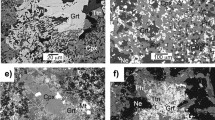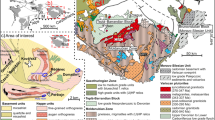Abstract
Igneous garnets have the potential to strongly fractionate rare earth elements (REE). Yet informations on partition coefficients are very scant, and criteria for distinguishing between hydrothermal and magmatic garnets are ambiguous. To fill this gap, we present trace element and isotopic data for two types of Ca-rich garnets from phonolites (Mt. Somma-Vesuvius). Both Ca-garnet populations are different in their style and dynamics of fractionation: one population is progressively strongly depleted in HREE from core to rim, reflecting REE fractionation in the host phonolite via earlier-crystallized garnets. Such examples for extreme changes in HREE in garnets are only known for hydrothermal grandites by REE-bearing fluids. The second garnet population is homogeneous and formed in a closed system. Near-flat patterns between Sm and Lu confirm experimental data indicating lower D(Sm)/D(Lu) for Ca-rich garnets than for e.g. pyrope-rich garnets. It follows: D Grt/PhMelt for La = 0.5, Sm = 48 and Yb = 110.













Similar content being viewed by others
References
Adam J, Green TH (1994) The effects of pressure and temperature on the partitioning of Ti, Sr and REE between amphibole, clinopyroxene and basanitic melts. Chem Geol 117:219–233
Amthauer G, Annersten H, Hafner SS (1977) The Mössbauer spectrum of 57Fe in titanium-bearing andradites. Phys Chem Miner 1:399–413
Armbruster T, Birrer J, Libowitzky E, Beran A (1998) Crystal chemistry of T-bearing andradites. Eur J Mineral 5:907–921
Aulinas M, Civetta L, Di Vito M, Orsi G, Gimeno D, Fernandez JL, Fernanadez Turiel JL (2007) The Plinian Mercato eruption of Mt. Somma-Vesuvius: magma chamber processes and eruption dynamics. Bull Volcanol (in press)
Ayuso AA, De Vivo B, Rolandi G, Seal II R, Paone A (1998) Geochemical and isotope (Nd-Pb-Sr-O) variations bearing on the genesis of volcanic rocks from Vesuvius, Italy. J Volcanol Geotherm Res 82:53–78
Cioni R (2000) Volatile content and degassing processes in the AD 79 magma chamber at Vesuvius (Italy). Contrib Mineral Petrol 140:40–54
Cioni R, Civetta L, Marianelli P, Metrich N, Santacroce R, Sbrana A (1995) Compositional layering and syn-eruptive mixing on a periodically refilled shallow magma chamber: the AD 79 Plinian eruption of Vesuvius. J Petrol 36:739–776
Cioni R, Marianelli P, Santacroce R (1998) Thermal and compositional evolution of the shallow magma chambers of Vesuvius: evidence from pyroxene phenocrysts and melt inclusions. J Geophys Res Solid Earth 103:18277–18297
Cioni R, Marianelli P, Santacroce R (1999a) Temperature of Vesuvius magmas. Geology 27:443–446
Cioni R, Santacroce R, Sbrana A (1999b) Pyroclastic deposits as a guide for reconstructing the multi-stage evolution of the Mt. Somma-Vesuvius Caldera. Bull Volcanol 60:207–222
Civetta L, Orsi G, Scandone P, Pece R (1978) Eastwards migration of the Tuscan anatectic magmatism due to anticlockwise rotation on the Apennines. Nature 279:604–605
Civetta L, Galati R, Santacroce R (1991) Magma mixing and convective compositional layering within the Vesuvius magma chamber. Bull Volcanol 53:287–300
Civetta L, D'Antonio M, De Lorenzo S, Di Rienzo V, Gasparini P (2004) Thermal and geochemical constrains on the “deep” magmatic structure of Mt. Vesuvius. J Vocanol Geotherm Res 133:1–12
D'Antonio M, Tonarini S, Arienzo I, Civetta L, Di Renzo V (2007) Components and processes in the magma genesis of the Phlegrean Volcanic District. Bull Geol Soc Am (in press)
De Natale G, Troise C, Pingue F, Mastrolorenzo G, Pappalardo L (2006) The Somma-Vesuvius volcano (Southern Italy): structure, dynamics and hazard evaluation. Earth Sci Rev 74:73–111
De Vivo B, Rolandi G, Gans PB, Calvert A, Bohrson WA, Spera FJ, Belkin HE (2001) New constraints on the pyroclastic eruptive history of the Campanian volcanic Plain (Italy). Mineral Petrol 73:47–65
Dorendorf F, Wiechert U, Wörner G (2000) Hydrated sub-arc mantle: a source for the Kluchevskoy volcano, Kamchatka/Russia. Earth Planet Sci Lett 175:69–86
Elter P, Grasso M, Parotto M, Mezzani L (2003) Structural setting of the Apennine-Maghrebian thrust belt. Episodes 26:205–211
Ferguson LJ and Edgar AD (1978) Petrogenesis and origin of analcime in volcanic-rocks of Crows-Nest formation, Alberta. Can J Earth Sci 15:66–77
Fulignati P, Marianelli P, Santacroce R, Sbrana A (2004) Probing the Vesuvius magma chamber–host rock interface through xenoliths. Geol Mag 141:417–428
Fulignati P, Panichi C, Sbrana A, Caliro S, Gioncada A, Del Moro A (2005) Skarn formation at the walls of the 79 AD magma chamber of Vesuvius (Italy): mineralogical and isotope constraints. Neues Jahrbuch der Mineralogie (Abhandlungen) 181:53–66
Gilg HA, Lima A, Somma R, Belkin HE, De Vivo B, Ayuso RA (2001) Isotope geochemistry and fluid inclusion study of skarns from Vesuvius. Mineral Petrol 73:145–176
Gomes CDB (1969) Electron microprobe analysis of zoned melanites. Am Mineral 54:1654–1669
Green TH (1977) Garnet in silicic liquids and its possible use as a P–T indicator. Contrib Mineral Petrol 65:59–67
Guest J, Cole P, Duncan A, Chester D (2003) Volcanoes of Southern Italy. The Geological Society Publishing House, London, pp 284
Hartmann G (1994) Late-medieval glass manufacture in the Eichsfeld Region (Thuringia, Germany). Chemie der Erde 54:103–128
Hauri EH, Wagner TP, Grove TL (1994) Experimental and natural partitioning of Th, U, Pb and other trace elements between garnet, clinopyroxene and basaltic melts. Chem Geol 117:149–166
Huggins FE, Virgo D, Huckenholz HG (1977) Titanium containing silicate garnets II. The crystal chemistry of melanites and schorlomites. Am Mineral 62:646–665
Irving AJ and Frey FA (1978) Distribution of trace-elements between garnet megacrysts and host volcanic liquids of Kimberlite to Rhyolitic composition. Geochimica et Cosmochimica Acta 42:771–787
Johnson KTM, (1998) Experimental determination of partition coefficients for rare earth and high-field-strength elements between clinopyroxene, garnet, and basaltic melt at high pressure. Contrib Mineral Petrol 133:60–68
Kohn MJ and Valley JW (1998) Effects of cation substitution in garnet and pyroxene on equilibrium oxygen isotope fractionations. J Metamorph Geol 16:625–639
Lackey JS, Valley JW, Hinke HJ (2006) Deciphering the source and contamination history of peraluminous magmas using δ18O of accessory minerals: examples from garnet-bearng plutons of the Sierra Nevada batholith. Contrib Mineral Petrol 151:20–44
Lang JR, Lueck B, Mortensen JK (1995) Triassic-Jurassic silica-undersaturated and silica-saturated alkalic intrusions in the Cordillera of British-Columbia—implications for arc magmatism. Geology 23:451–454
Lavecchia G and Stoppa F (1996) The tectonic significance of Italian magmatism: an alternative view to the popular interpretation. Terra Nova 8:435–446
Lima A, Danyueshevsky LV, De Vivo B, Fedele L (2003) A model for the evolution of the Mt. Somma-Vesuvius magmatic system based on fluid and melt inclusions investigations. In: De Vivo B, Bodran RJ (eds) Melts inclusions in volcanic systems: methods, applications and problems. Series development in Volcanology. Elsevier, Amsterdam, pp 227–249
Linnen RL, Keppler H (2002) Melt composition control of Zr/Hf fractionation in magamtic processes. Geochimica et Cosmochimica Acta 66:3293–3301
Mahood GA, Stimac JA (1990) Trace-element partitioning in pantellerites and trachytes. Geochimica et Cosmochimica Acta 54:2257–2276
Meagher EP (1982) Silicate garnets. In: Ribbe PH (ed) Orthosilicates, 2nd edn. Rev Mineral Geochem 5:25–66
Nagasawa H (1970) Rare Earth concentrations in zircon and apatite and their host dacite and granites. Earth Planet Sci Lett 9:359–364
Naimo D, Balassone G, Beran A, Amalfitano C, Imperato M, Stanzione D (2003) Garnets in volcanic breccias of the Phlegraean Fields (southern Italy): mineralogical, geochemical and genetic features. Mineral Petrol 77:256–270
Orsi G, de Vita S, Di Vito M (1996) The restless, resurgent Campi Flegrei nested caldera (Italy): constraints on its evolution and configuration. J Volcanol Geotherm Res 74:179–214
Paone A (2004) Evidence of crustal contamination, sediment, and fluid components in the Campanian volcanic rocks. J Volcanol Geotherm Res 138:1–26
Peccerillo A (1999) Multiple mantle metasomatism in central-southern Italy: geochemical effects, timing and geodynamic implications. Geology 27:315–318
Pertermann M, Hirschmann MM, Hametner K, Günther D, Schmidt MW (2004) Experimental determination of trace element partitioning between garnet and silica-rich liquid during anhydrous partial melting of MORB-like eclogite. Geochem Geophys Geosyst 5:2003GC000638
Rocholl A, Dulski P, Raczek I (1997) Chemical characterisation of NIST silicate glass certificate reference material SRM 610 by ICP-MS, TIMS, LIMS, SSMS, INAA, AAS and PIXE. Geostand Newsl 21:101
Russell JK, Dipple GM, Lang JR, Lueck B (1999) Major-element discrimination of titanian andradites from magmatic and hydrothermal environments: an example from the Canadian Cordillera. Eur J Mineral 6:919–935
Salters VJM and Longhi J (1999) Trace element partitioning during the inital stages of melting beneath mid-ocean ridges. Earth Planet Sci Lett 166:15–30
Santacroce R (1983) A general model for the behaviour of the Somma Vesuvius volcanic complex. J Volcanol Geotherm Res 17:237–248
Scaillet B and Pichavant M (2004) Crystallisation conditions of Vesuvius phonolites. Geophys Res Abstr 6:03764
Scordari F, Schingaro E, Pedrazzi G (1999) Crustal chemistry of melanites from Mt. Vulture (Southern Italy). Eur J Mineral 11:855–869
Shimizu N (1974) An experimental study of the partitioning of K, Rb, Cs, Sr, and Ba between clinopyroxene and liquid at high pressures. Geochimica et Cosmochimica Acta 38:1789–1798
Sisson TW, Bacon CR (1992) Garnet—high-silica rhyolite trace-element partition coefficients measured by ion microprobe. Geochimica et Cosmochimica Acta 56:2133–2136
Smith MP, Henderson P, Jeffries TER, Long J, Williams CT (2004) The rare earth elements and uranium in garnets from the Beinn and Dubhaich Aureole Skye, Scotland, UK: constraints on Processes in a dynamic hydrothermal system. J Petrol 45:457–484
Somma R, Ayuso RA, De Vivo B, Rolandi G (2001) Major, trace element and isotope geochemistry (Sr-Nd-Pb) of interplinian magmas from Mt. Somma-Vesuvius (Southern Italy). Mineral Petrol 73:121–143
Turbeville BN (1993) Sidewall differentiation in an alkalic magma chamber—evidence from syenite in tuffs of the Latera Caldera, Italy. Geol Mag 130:453–470
Turi B, Taylor HP (1976) Oxygen isotope studies of potassic volcanic rocks of Roman Province, Central Italy. Contrib Mineral Petrol 55:1–36
Valley JW, Kitchen N, Kohn MJ, Niendorf CR, Spicuzza MJ (1995) UWG-2, a garnet standard for oxygen isotope ratios: strategies for high precision and accuracy with laser heating. Geochimica et Cosmochimica Acta 59:5223–5231
Vielzeuf D, Vechambre M, Brunet F (2005) Oxygen isotope heterogenieties and diffusional profiles in composite metamorphic/magamtic garnets from the Pyrenees. Am Mineral 90:463–472
Watson EB, Harrison TM (1983) Zircon saturation revisited: temperature and composition effects in a variety of crustal magma types. Earth Planet Sci Lett 64:295–304
Westrenen W, Blundy J, Wood B (1999) Crystal-chemical controls on trace element partitioning between garnet and anhydrous silicate melt. Am Mineral 84:838–847
Westrenen W, Blundy JD, Wood BJ (2001) High field strength element/rare earth element fractionation during partial melting in the presence of garnet: implications for identification of mantle heterogeneities. Geochem Geophys Geosyst 2. doi:2000GC000133
Zollo A et al (1996) Seismic evidence for a low-velocity zone in the upper crust beneath Mount Vesuvius. Science 274:592–594
Acknowledgment
We are grateful to the members of the Osservatorio Vesuviano for selecting samples and showing appropriated outcrops for sampling Mercato and Avellino pumices. For technical assistance we thank Reinhold Przybilla, Gaby Mengel, Angelika Reitz, Erwin Schiffcyk and Ingrid Reuber. B.S. is particularly grateful to Dan Morgan and Burkhard Schmidt for fruitful discussions about the origin and growth of grandites in a skarn-forming environment. We are also indebted to T.L. Grove, Trevor Green and Roberto Ayuso for very constructive comments. This study was funded by the 5th Framework Programme of the European Union within the ERUPT project. We thank in particular Jon Davidson for setting up and leading the ERUPT project.
Author information
Authors and Affiliations
Corresponding author
Additional information
Communicated by T. L. Grove.
Rights and permissions
About this article
Cite this article
Scheibner, B., Wörner, G., Civetta, L. et al. Rare earth element fractionation in magmatic Ca-rich garnets. Contrib Mineral Petrol 154, 55–74 (2007). https://doi.org/10.1007/s00410-006-0179-z
Received:
Accepted:
Published:
Issue Date:
DOI: https://doi.org/10.1007/s00410-006-0179-z




